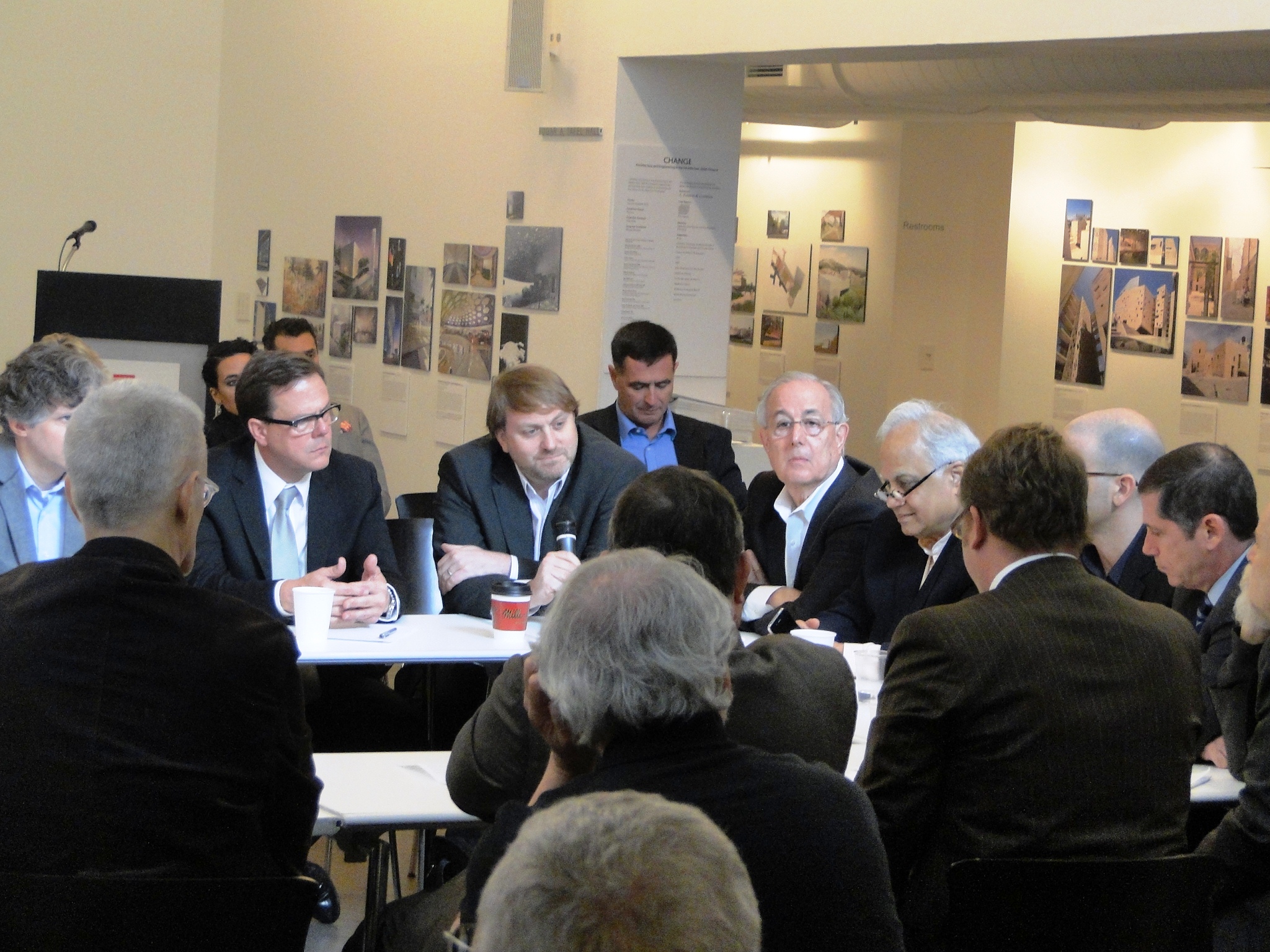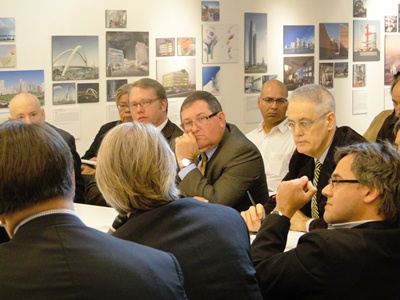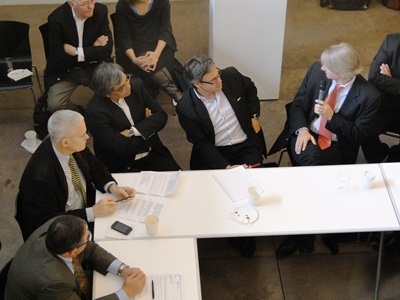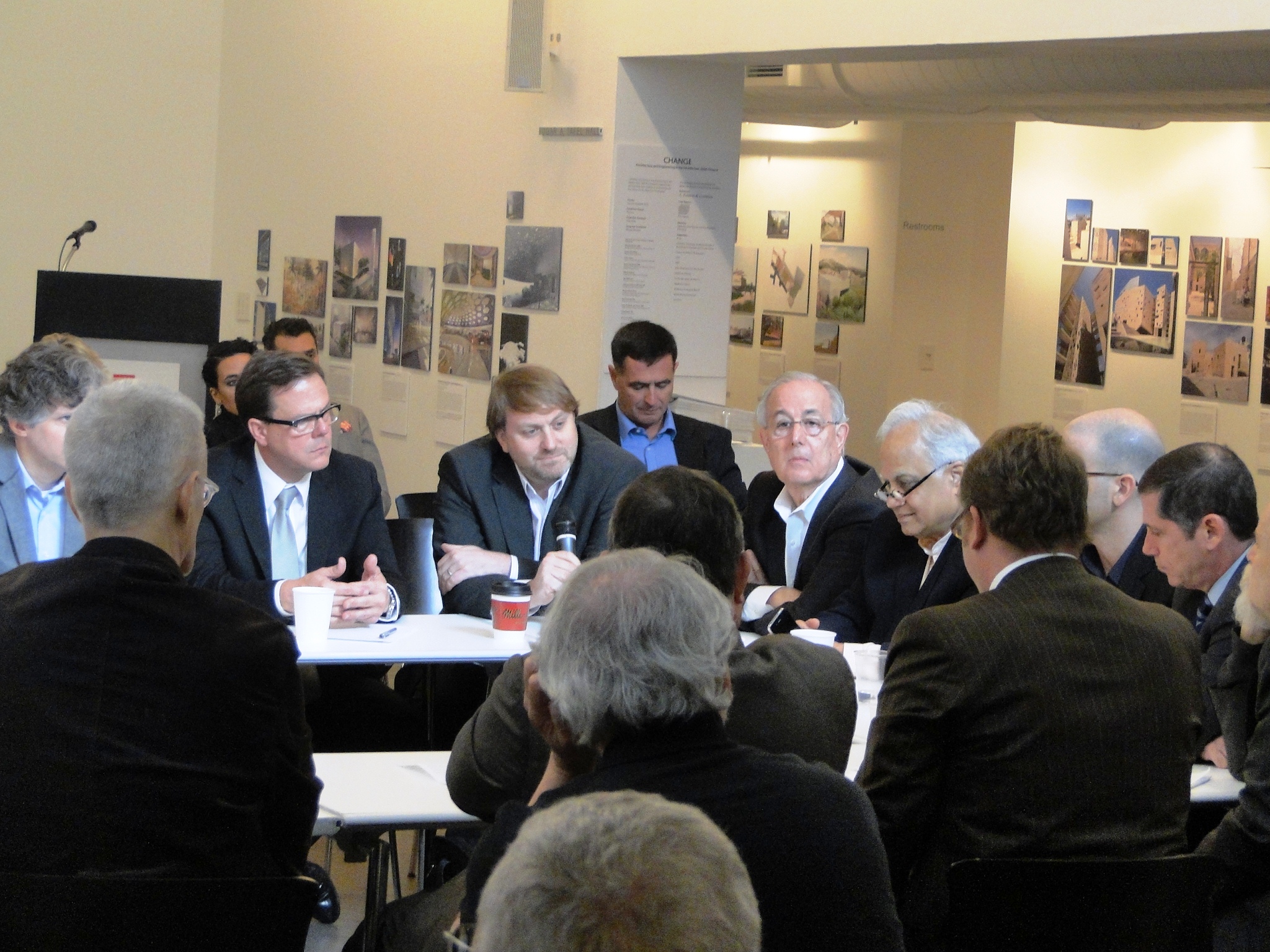by: Jill Lerner FAIA

Participants including Fred Schwartz, FAIA, Mustafa Abadan, William Menking (Moderator), and Rafi Segal discuss practice in the Middle East.
Berit Hoff

With the reality of limited design opportunities in the US in recent years, practitioners cited the need to “go where the work is.”
Berit Hoff
Event: Practice in the Middle East
Location: Center for Architecture, 05.08.2012
Introduction: Jill Lerner, FAIA, Kohn Pedersen Fox, 2013 AIANY President-Elect
Respondent: Rick Bell, FAIA, Executive Director, AIANY
Panelists: Rafi Segal, Rafi Segal Architects; Anthony Mosellie, AIA, KPF; Anthony Fieldman, Perkins+Will; Jay Liese, Corgan; Fred Schwartz, FAIA, Frederic Schwartz Architects; Ed Mayor, FX FOWLE; Sudhir Jambhekar, FAIA, FX FOWLE; JR Radtke, 360 Architects; Craig Schwitter, Buro Happold; Bryon Stigge, Buro Happold; Michael Kostow, AIA, Kostow Greenwood Architects; Reid Freeman, Jamie Carpenter Design Associates; Kyle Krall, Thornton Tomasetti; Bart Voorsanger, FAIA, Voorsanger Architects; Mustafa K. Adaban, SOM; Ashok Raiji, Assoc. AIA, ARUP
Moderator: Bill Menking, The Architect’s Newspaper
Organizers: The event was curated and organized by Jeffrey A. Kenoff, AIA, Bruce E. Fisher, AIA and Lynn Fritzlen, AIA, LEED AP; AIANY Global Dialogues and Professional Practice Committees; a program of the exhibitions “Change: Architecture and Engineering in the Middle East, 2000-Present” and “City of Mirages: Baghdad, 1952-1982″
Sponsors: A. Estéban and Co. (benefactor); Buro Happold (lead sponsor); Eytan Kaufman Design and Development, FXFOWLE (sponsors); Arup, Columbia University Graduate School of Architecture, Planning, and Preservation, Dewan Architects & Engineers, GAD, HDR, Kohn Pedersen Fox Associates, NAGA Architects, Ramla Benaissa Architects, RBSD Architects, Skidmore, Owings & Merrill, World Monuments Fund, Zardman (supporters)
Inspired by Jill Lerner, FAIA, a principal at Kohn Pedersen Fox and 2013 AIANY president-elect, and AIANY executive director Rick Bell, FAIA, the AIANY Global Dialogues and Professional Practice Committees joined forces to host “Practice in the Middle East.” The event promoted a round table discussion structured by the scope of “CHANGE: Architecture and Engineering in the Middle East, 2000-Present,” now on view at the Center for Architecture. Architects who contributed to the exhibit and local experts working in the Middle East comprised the group, and moderator Bill Menking of The Architect’s Newspaper moderated the discussion that explored how firms practice in the region and the subsequent need to balance risks and rewards with the ever-present challenges and prospects.
Given the extreme economic and cultural differences in the Middle East, it is little wonder that the politics of place was a recurrent theme. Despite the lack of women at the table noted by all, in general participants agreed on many points, emphasizing the design opportunities, high aspirations, and the region’s widespread desire for “something new.” A sustained commitment to the area was described to be the key to success in the relationship-based economy. Sudhir Jambhekkar from FXFOWLE mentioned the US government’s helpfulness when working abroad, and in general, Americans and US-based firms are welcome and appreciated for their skill and expertise. Listening to the discussion, it was clear that in this sense we are cultural ambassadors in the midst of cultural and political change. The impact of the Arab Spring suggested a shift from buildings signifying “greed and gaud,” as one discussant remarked, to a new focus on “projects for the people” such as schools and hospitals.
With the reality of limited design opportunities in the US in recent years, most Middle East practitioners cited the need to “go where the work is.” The greatest opportunities (and greatest need) are noticeably in risky places such as Iraq, Libya, and Egypt, which can pose safety hazards. Difficult contracts were also noted, and while long negotiations were seen as expected, it was evident that negotiating a good contract requires patience, time, and “a lot of tea.”
Many in the room professed, however, aspirations to provide greater good and an improved civic environment through high-quality design. Some on the panel were skeptical of these well-intentioned motives, but all agreed that at our core, the design and engineering communities excel at solving large-scale problems – a skill greatly needed throughout the Middle East.
Jill Lerner, FAIA, is a principal at Kohn Pedersen Fox and AIANY’s 2013 president-elect. Her 2013 presidential theme will be called “Global Cities, Global Practice.”











